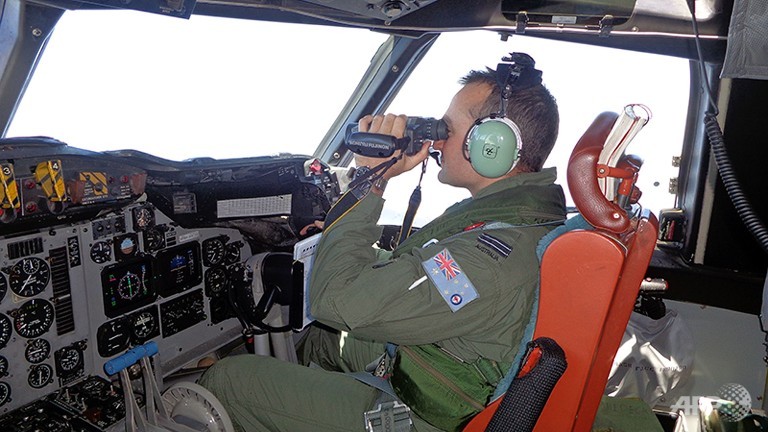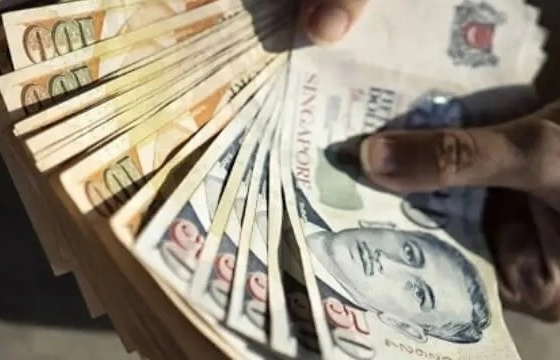Search for MH370 to continue even after 30 days: Hishammuddin

A pilot of an AP-3C Orion maritime patrol aircraft scanning the surface of the sea during a search operation for the missing Malaysia Airlines Flight MH370. (AFP/Royal Australian Airforce)
>> No sign of Malaysian jet; search will be "long haul"
SEPANG: The search for the missing Malaysia Airlines Flight MH370 will continue even after the end of 30 days, which is when the black box batteries will run out, said Acting Transport Minister Hishammuddin Hussein on Friday.
In a daily press briefing on the latest development related to the search for MH370, he said there are other technologies that could be used for the search and rescue (SAR) operation.
"We have not found anything concrete yet," he said. "This is going to be a long haul," Hishammuddin told reporters at the press briefing.
The minister said based on the information given by the French team involved in the search for Air France 447, other SAR technologies could be used after 30 days of unfruitful search.
"We will continue the search, we are still determined to find and to rescue (those involved)," he said, while expressing hope that the aircraft would be found before the search entered its 30th day.
The Beijing-bound Boeing 777-200ER aircraft, with 227 passengers and 12 crew on board, disappeared about an hour after leaving the KL International Airport at 12.41am on March 8. It was scheduled to arrive in Beijing at 6.30am on the same day.
The fate of the passengers is unknown as the multi-national search for the aircraft has drawn a blank so far.
The French Aviation Safety Agency (BEA) team arrived on Monday to assist the Malaysia-led international investigating team in the search for the missing aircraft, with their focus on undersea search.
In 2009, the BEA team was involved with the Air France 447 crash that killed all 228 people aboard, and the black box of the unfortunate plane was only found two years after the tragedy.
The search for MH370 has been extended to cover a large tract west of Malaysia, including the Indian Ocean, when it was learnt that the plane had veered off course after someone deliberately switched off the communication system on board and the plane had flown for seven hours after that.
The search is also focused on two corridors, namely the northern corridor which stretches from the border of Kazakhstan and Turkmenistan to northern Thailand, and the southern corridor which stretches from Indonesia to the southern Indian Ocean.
Hishammuddin said Malaysia was in the midst of discussing with a team of French experts concerning the use of other technologies, other than the black box, to locate the aircraft.
He also said he had been in contact with a few leaders of countries which had the pinger locator hydrophones technology that was used by the French investigation team to locate Air France 447's black box.
"Only limited countries have the capabilities and I have been talking to the leaders of those countries for the possibility of using the technology," he said.
On the updates of the satellite images regarding two objects located in the south Indian Ocean, Hishammuddin said as of 5.40pm on Friday, there was no positive breakthrough from Australian authorities.
Describing the image of the object as "a speck in the ocean", he said the experts would be able to differentiate one speck in the ocean from another.
Hishammuddin reiterated that the southern corridor had always been a challenge in the search and rescue operations.
He said: "I would have to thank the Australian authorities and also expertise from the United States. I would be seeking further assistance from the US Secretary of Defence Chuck Hagel later today.
"Malaysia will be asking the US to send underwater vehicles for deep-sea salvage as part of a joint-multinational effort to find the missing passenger jet."
Hishammuddin said he would reveal the next plan in the southern corridor, in the event the SAR operation failed to find the objects linked to the missing aircraft.
"The southern corridor faces its own challenges, such as the weather, the depth of sea and waves. If we do not find it within 30 days, then it raises other issues on how to locate it, and how the French investigation team took two years, and that comes into a different realm of SAR," he said.
Meanwhile, Australia's deputy prime minister said the suspected debris spotted in the remote southern Indian ocean may have sunk.
Friday's search over the treacherous seas about 2,500 kilometres (1,500 miles) southwest of Perth concluded "without any sightings", the Australian Maritime Safety Authority (AMSA) said in a statement.
The planes flew low under the cloud cover rather than rely on radar, after poor weather the day before hampered the search.
"Something that was floating on the sea that long ago may no longer be floating," Deputy Prime Minister Warren Truss told reporters in Perth.
"It may have slipped to the bottom," he added.
If debris is found, the mammoth task remains of locating the "black box" flight data recorder, which offers the best chance of peeling back the layers of confusion and mystery surrounding MH370.
There has been little progress in what essentially became a criminal investigation after it was determined that the disappearance of the plane was probably deliberate.
Malaysia has asked the FBI to help recover data it said was deleted from a home flight simulator belonging to the plane's chief pilot, Captain Zaharie Ahmad Shah, but otherwise no evidence has emerged to implicate him.
Malaysia Airlines CEO Ahmad Jauhari Yahya confirmed that the aircraft had been carrying lithium ion batteries in its cargo hold, but dismissed suggestions that they might have been the source of a fire that caused the plane to crash.
"These are not regarded as dangerous goods... and were packed as recommended by the International Civil Aviation Organization," Ahmad Jauhari said.
What the stars mean:
★ Poor ★ ★ Promising ★★★ Good ★★★★ Very good ★★★★★ Exceptional
Latest News
More News
- Thailand seeks to promote digital training (November 04, 2024 | 16:14)
- Indonesia attracts foreign investment in technology sector (November 04, 2024 | 16:08)
- Tropical storm Trami leaves at least 24 people dead in Philippines (October 24, 2024 | 17:36)
- Singapore grants conditional approval for solar power import from Australia (October 24, 2024 | 17:27)
- ASEAN digital economy set to reach $2 trillion by 2030 (October 22, 2024 | 15:08)
- Thailand asks Laos to waive visa fee at border checkpoints to boost tourism (October 21, 2024 | 17:23)
- Laos pledges to continue efforts to empower girls (October 21, 2024 | 17:17)
- Chinese electric vehicle maker to build plant in Indonesia (October 21, 2024 | 17:12)
- Vietnam Elevator Association introduces Elevator Safety Application to the world (October 18, 2024 | 09:00)
- A taste of the future - the go-to spot at the Worldchefs Congress & Expo 2024 (October 15, 2024 | 16:11)

















 Mobile Version
Mobile Version